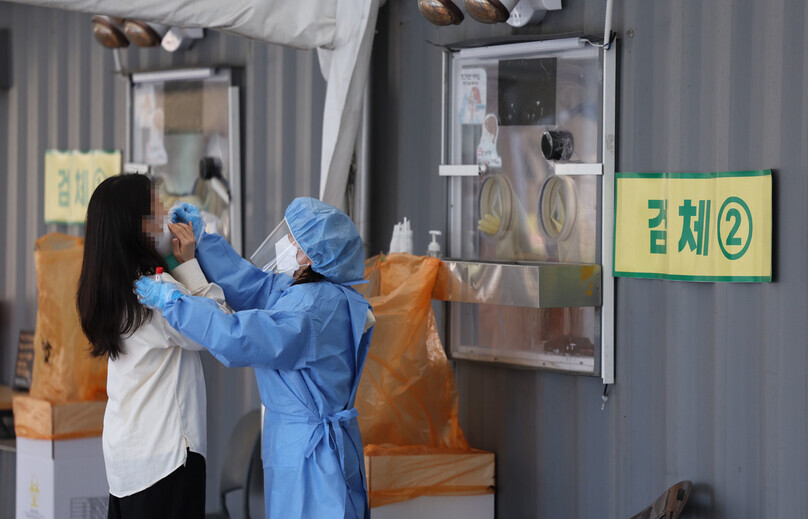hankyoreh
Links to other country sites 다른 나라 사이트 링크
S. Korea’s COVID-19 caseload falls below 100,000 for first time in 48 days

The new daily COVID-19 caseload fell below 100,000 for the first time in 48 days on Sunday.
The seven-day average of new cases per day was also down by roughly half from its peak three weeks earlier.
As of the end of the day on Sunday, the Central Disease Control Headquarters had counted 90,928 new confirmed cases, including 21 among arriving international travelers. This was the first time the total had fallen below 100,000 in the 48 days since Feb. 22, when it stood at 99,562.
The seven-day average of new domestic cases per day, which provides a gauge of trends with the current wave, was calculated at 218,472 for the week of April 3–9. This was down from a peak above 400,000 three weeks earlier during the third week of March (March 13–19), when it reached 404,548.
With the National Institute for Mathematical Sciences predicting on April 6 that the average daily new caseload would reach the 200,000–300,000 range by around April 20 under the current social distancing system, the figures mean the level has been reached earlier than expected.
Critical cases and deaths have not fallen substantially. Critical cases were down to 1,099 on Sunday compared with 1,315 on March 31, but remained in excess of 1,000 for a 35th straight day. The seven-day average of deaths per day was down slightly to 312.3 for the week of April 4–10 compared with 359.4 for the fourth week of March (March 20–26).
“With the number of critical cases and deaths showing a gradual trend of decline, we believe the peak has been passed,” said Son Young-rae, director of the Central Disaster Management Headquarters’ social strategy unit.
Meanwhile, the South Korean government is planning to announce a “post-Omicron response system” this week, in addition to the adjusted social distancing measures it plans to apply next week.
Beyond core prevention guidelines such as the wearing of masks indoors, the government plans to loosen restrictions on business operating hours, the number of people allowed at private gatherings, and large-scale events. It has also begun discussions on various other aspects of disease control and healthcare systems, including the lowering of the legal infectious disease classification from Class 1 to Class 2 and adjusting the isolation period for those who test positive.
By Lim Jae-hee, staff reporter; Jang Hyeon-eun, staff reporter
Please direct questions or comments to [english@hani.co.kr]

Editorial・opinion
![[Editorial] Does Yoon think the Korean public is wrong? [Editorial] Does Yoon think the Korean public is wrong?](https://flexible.img.hani.co.kr/flexible/normal/500/300/imgdb/original/2024/0417/8517133419684774.jpg) [Editorial] Does Yoon think the Korean public is wrong?
[Editorial] Does Yoon think the Korean public is wrong?![[Editorial] As it bolsters its alliance with US, Japan must be accountable for past [Editorial] As it bolsters its alliance with US, Japan must be accountable for past](https://flexible.img.hani.co.kr/flexible/normal/500/300/imgdb/original/2024/0417/6817133413968321.jpg) [Editorial] As it bolsters its alliance with US, Japan must be accountable for past
[Editorial] As it bolsters its alliance with US, Japan must be accountable for past- [Guest essay] Amending the Constitution is Yoon’s key to leaving office in public’s good graces
- [Editorial] 10 years on, lessons of Sewol tragedy must never be forgotten
- [Column] A death blow to Korea’s prosecutor politics
- [Correspondent’s column] The US and the end of Japanese pacifism
- [Guest essay] How Korea turned its trainee doctors into monsters
- [Guest essay] As someone who helped forge Seoul-Moscow ties, their status today troubles me
- [Editorial] Koreans sent a loud and clear message to Yoon
- [Column] In Korea’s midterm elections, it’s time for accountability
Most viewed articles
- 1[Column] The clock is ticking for Korea’s first lady
- 2[Guest essay] How Korea turned its trainee doctors into monsters
- 3Samsung barricades office as unionized workers strike for better conditions
- 4S. Korea, Japan reaffirm commitment to strengthening trilateral ties with US
- 5[Editorial] When the choice is kids or career, Korea will never overcome birth rate woes
- 6Gangnam murderer says he killed “because women have always ignored me”
- 7[Editorial] As it bolsters its alliance with US, Japan must be accountable for past
- 8[News analysis] After elections, prosecutorial reform will likely make legislative agenda
- 9Korea, Japan jointly vow response to FX volatility as currencies tumble
- 10US exploring options for monitoring N. Korean sanctions beyond UN, says envoy